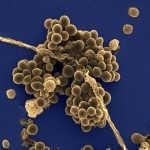Link to Pubmed [PMID] – 15956429
J. Clin. Microbiol. 2005 Jun;43(6):2952-4
A total of 212 coagulase-negative Staphylococcus strains recovered prospectively during 119 surgeries for proven or suspected bone and joint infection (BJI) were identified by sodA sequencing. These strains were identified as 151 Staphylococcus epidermidis isolates, 15 S. warneri isolates, 14 S. capitis isolates, 9 S. hominis isolates, 6 S. lugdunensis isolates, 5 S. haemolyticus isolates, 4 S. caprae isolates, 4 S. pasteuri isolates, 3 S. simulans isolates, and 1 S. cohnii isolate. Only S. epidermidis, S. lugdunensis, S. capitis, and S. caprae were found to be infecting organisms and were involved, respectively, in 35 (81.4%), 3 (7.0%), 3 (7.0%), and 2 (4.6%) cases of BJI.

